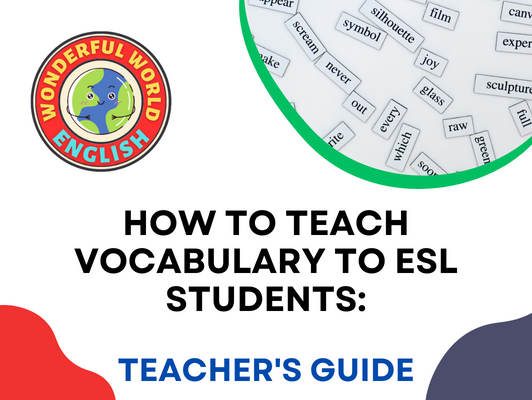
Meet David De’ Ath, founder, editor, and writer at Wonderful World English. With his extensive background as an English teacher, David provides valuable insights and practical tips on ESL for students and teachers alike.
Teaching vocabulary to ESL students is a multifaceted process that extends beyond mere word memorization.
Effective vocabulary instruction encompasses a deep understanding of the student’s unique linguistic backgrounds, learning styles, and contextual usage of language.
Educators must employ a variety of teaching strategies to meet the diverse needs of learners and ensure that they can use new vocabulary fluently and appropriately.
Creating an environment conducive to learning is crucial.
This involves designing engaging lessons and incorporating a range of resources, from visual aids to interactive activities.
Continuous assessment serves as a vital component, providing teachers and students with feedback essential for improvement and tailored support.
These steps form the foundation for successful vocabulary acquisition among ESL students.
This guide will explore these major steps on how to teach vocabulary to English learners successfully.
We are a team of experienced educators and we aim to give you insights and guidance into the world of teaching ESL.
Key Takeaways
- Vocabulary teaching must address individual student needs and learning styles.
- An engaging environment with diverse resources enhances vocabulary learning.
- Regular assessment is crucial for continuous language development.
Understanding the Needs of ESL Students
To support ESL students effectively, it’s essential to recognize the challenges they face and understand the crucial role vocabulary plays in language learning.
Identifying Common Challenges
ESL students often encounter a range of obstacles as they work to acquire a new language.
One fundamental issue is limited exposure to English in their daily lives, which can severely impede the frequency and depth of interactions with the language.
Additionally, students may struggle with different phonetic sounds that are not present in their mother tongue, making pronunciation a tough barrier to overcome.
They also face the challenge of understanding idiomatic expressions and colloquial language, which are rarely logical and can vary widely across different English-speaking regions.
Confidence can be another significant hurdle, as fear of making mistakes can inhibit their willingness to actively use new vocabulary in conversation.
Importance of Vocabulary in Language Learning
The breadth of a student’s vocabulary is a determining factor in their ability to express thoughts and engage in meaningful communication.
Without an extensive vocabulary, ESL students may find it difficult to articulate ideas, participate actively in dialogues, or comprehend texts with the nuance and depth required for full understanding.
Building a sizeable vocabulary is not merely about learning isolated words but also about grasping the usage, context, and connotations that come with them.
The importance of vocabulary extends beyond communication to influence ESL students’ overall confidence in using the language.
With each new word learned, students can feel a sense of achievement that bolsters their self-assurance and encourages further language exploration.
Effective Teaching Strategies
In the realm of ESL teaching, employing a variety of teaching strategies ensures vocabulary lessons are both engaging and effective.
Utilizing technology, creating interactive experiences, and reinforcing learning through repetition and review are cornerstones of a successful vocabulary curriculum.
Incorporating Technology and Multimedia
Teachers can enhance vocabulary lessons through technology and multimedia, which provide dynamic and visual contexts that aid memory retention.
For instance, using language learning apps or online flashcards allows for an interactive experience where visual and auditory cues help solidify word understanding and usage
- Language Learning Apps: Incorporate apps designed for vocabulary building with features for audio pronunciation and interactive quizzes.
- Interactive Whiteboards: Utilize to present multimedia content and encourage students to engage with the material directly.
Active Learning through Games and Activities
Teachers who include games and activities in their vocabulary lessons increase engagement and motivation, transforming passive learning into an active process.
- Vocabulary Games: Games like ‘Word Bingo’ or ‘Memory Match’ can provide a fun and competitive way to review vocabulary.
- Role-Playing: Encourages students to use new words in context, thereby facilitating deeper learning.
The Role of Repetition and Review
Consistent repetition and review are vital in reinforcing word retention and usage.
Lessons should be structured to revisit vocabulary at spaced intervals, which helps transfer words from short-term to long-term memory.
- Spaced Repetition: Implement a schedule that revisits vocabulary after increasing intervals of time.
- Review Sessions: Regular, brief review exercises can help cement the retention of words learned.

Creating a Conducive Learning Environment
A conducive learning environment in ESL settings is pivotal for vocabulary acquisition.
Such an environment leverages collaboration and interaction while also fostering individual confidence and a healthy sense of competition.
Promoting Collaboration and Interaction
In ESL classrooms, collaboration is key to language development.
When students work together, they exchange knowledge and negotiate meaning, which reinforces new vocabulary.
One should establish routines that encourage cooperative learning, such as:
- Pair Work: Assigning partners to discuss new words or phrases.
- Group Projects: Groups can create vocabulary-based presentations or posters.
- Language Games: Incorporating games that require communicative cooperation boosts vocabulary retention.
Through these collaborative activities, learners not only practice new vocabulary but also build social linguistic skills, which are essential in real-world language use.
Confidence and Competition
Students also thrive in environments where they feel confident and motivated.
Introducing an element of competition can be invigorating, provided it’s managed well to avoid undue stress.
Effective strategies include:
- Spelling Bees: A classic form of competition that encourages accurate recall of vocabulary.
- Vocabulary Challenges: Timed activities where individuals or teams gain points for correct usage of new terms.
It’s crucial to balance these competitive elements with constant encouragement, offering praise to maintain students’ confidence.
In doing so, one makes the classroom environment a place of both striving and support, optimizing the learning experience for all participants.
Lesson Planning and Resource Utilization
Effective lesson planning in ESL education involves the strategic use of various resources to enhance vocabulary acquisition.
Teachers need to carefully integrate tools such as ESL vocabulary books and flashcards, as well as authentic materials like movies and TV shows, to create a rich and engaging learning environment.
Utilizing ESL Vocabulary Books and Flashcards
ESL vocabulary books are a cornerstone resource in lesson planning, offering structured content that can guide students through new words and their applications.
When incorporating vocabulary books, educators should aim to select texts that align with their students’ proficiency levels and learning objectives.
Complementing these books with flashcards can greatly reinforce memory retention.
Teachers can employ flashcards in a variety of engaging vocabulary exercises, such as matching games or quick-fire quizzes, to stimulate learning and enhance word retention.
Leveraging Authentic Materials
Bringing real-world context to ESL vocabulary learning can be achieved through the use of authentic materials.
Movies and TV shows, in particular, provide rich opportunities for students to hear new vocabulary used in natural settings.
Lesson plans that incorporate these materials should include targeted viewing activities where students can practice listening for specific vocabulary and phrases.
They can then discuss the meanings and usage in a classroom setting, facilitating a deeper understanding of language in a cultural context.
Using these kinds of materials makes learning more interesting and equips students with the language skills needed for real-life communication.

Assessment and Continuous Improvement
Assessment is pivotal in the realm of vocabulary acquisition for ESL students, providing both a framework to monitor progress and an avenue for iterative teaching strategies.
Continuous improvement hinges on efficient error correction mechanisms and retention-focused exercises, ensuring students receive appropriate feedback and build a robust lexicon over time.
Monitoring Progress with Vocabulary Exercises
Exercises are a cornerstone in assessing student vocabulary retention.
By employing a mix of matching activities, gap-fill sentences, and quizzes, instructors can track which words students are retaining and which need further reinforcement.
For example:
- Matching: Students demonstrate understanding by linking new vocabulary with definitions, synonyms, or pictures.
- Gap-fill: Filling in blanks within sentences helps test usage in context and aids retention.
Error correction during these exercises serves not only to rectify misunderstandings but also to reinforce correct usage, which supports long-term retention.
Adapting Teaching Methods Based on Feedback
Feedback from assessment exercises illuminates the effectiveness of teaching methods.
For instance:
- If students consistently struggle with certain words, this may indicate a need for more contextual learning or additional sensory engagement strategies.
- Conversely, consistent success might signal readiness for more advanced vocabulary challenges or faster-paced learning.
Adaptation might involve incorporating visual stimuli when introducing new vocabulary or adjusting the complexity of language used in examples based on student feedback.
This responsive approach fosters a tailored learning environment conducive to continuous vocabulary improvement.

Vocabulary-Building Activities
In addition to the strategies we’ve discussed, incorporating a variety of vocabulary-building activities can significantly enrich the learning experience in any classroom.
These activities, designed to complement the strategies above, can add depth and diversity to your vocabulary teaching approach.
The activities suggested here are not just educational but are also designed to be enjoyable and engaging, making learning new words more dynamic and interactive.
Whether through group exercises, individual tasks, or creative projects, these activities are tailored to stimulate students’ interest and encourage active participation in their learning journey.
Incorporating these activities into your lesson plans will aid in reinforcing the vocabulary and provide a more holistic and varied learning experience.
They are a great way to keep the classroom atmosphere lively and ensure students learn and have fun.
Let’s explore these activities and see how they can be a valuable addition to your teaching repertoire to enrich your students’ vocabulary:
1. Vocabulary Games

Word-related games are an effective and enjoyable method for teaching English vocabulary.
These games not only facilitate effortless learning but also add an element of fun to the classroom.
Popular games like word puzzles, including word searches, bingo, and charades, are excellent tools for reinforcing new vocabulary.
Small rewards, such as stickers for younger learners or more age-appropriate incentives for older students, can further enhance engagement and motivation.
These rewards are positive reinforcement, encouraging students to participate actively and learn enthusiastically.
Games like quizzes are fun and provide teachers with valuable insights into their students’ proficiency levels.
These activities can help identify individual strengths and weaknesses, allowing for more targeted and effective teaching strategies.
Moreover, such games foster a healthy sense of competition, making vocabulary learning a more enjoyable and interactive experience for both students and teachers.
The competitive aspect keeps students engaged and eager to learn more, making vocabulary acquisition an exciting challenge rather than a tedious task.
For a collection of the best games that can enhance vocabulary learning, check out the link below!
These games are carefully selected to maximize learning outcomes while ensuring students have an enjoyable and memorable learning experience.
Related Article: Best Games to Learn English: Ultimate Guide
2. Real-Life Situations

Integrating real-life situations into vocabulary lessons is a proven strategy to enhance retention and recall of new words.
When students can connect the vocabulary they learn with their daily experiences, it becomes more meaningful and memorable for them.
Teachers can foster this connection by encouraging students to use newly learned words in practical, everyday contexts.
This can be achieved through interactive classroom exercises that simulate real-life scenarios or by motivating students to apply their vocabulary outside the classroom, including at home.
Organizing field trips to common places like supermarkets, parks, or other community settings can also be incredibly effective.
These outings make lessons more engaging and provide students with tangible opportunities to practice and apply the vocabulary they’ve learned in real-world contexts.
Such experiential learning helps solidify the student’s understanding and use of new words, bridging the gap between theoretical knowledge and practical application.
This approach not only improves vocabulary skills but also boosts students’ confidence in using English in everyday situations.
3. Storytelling and Presentations

Storytelling and presentations are powerful tools for enhancing vocabulary learning.
By encouraging students to use the words they’ve learned in narratives or presentations, they can deepen their understanding and ability to use them effectively.
For older students, assigning projects that involve creating their own presentations or storytelling about aspects of their lives can be particularly beneficial.
This method reinforces their vocabulary, fosters creativity, and builds confidence.
It allows students to practice their language skills in a structured yet personal context, making the learning process more relevant and engaging.
Activities like creating posters or drawing pictures can be equally effective for younger learners.
These visual projects can then be used for students to come to the front of the class and talk about their work.
This approach not only aids in vocabulary reinforcement but also helps develop their public speaking and presentation skills at an early age.
These activities offer a creative outlet for students to express themselves while strengthening their grasp of English.
Whether through storytelling, presentations, or visual arts, these methods provide a dynamic and interactive way to enhance vocabulary learning.
4. Role-Playing Scenarios

Role-playing activities are an excellent method to make vocabulary learning more interactive and enjoyable.
By simulating real-life interactions, these activities provide a practical context for students to apply the vocabulary they’ve learned.
These role-playing scenarios can be conducted in various formats – pairs, groups, or between the teacher and a student.
This flexibility allows for a range of interactions and learning experiences.
It’s important for teachers to provide clear directions and objectives for these activities and constructive feedback afterward, highlighting strengths and areas for improvement.
Examples of role-play activities can include simulated phone calls, conversations with a family member, interactions with a waiter in a restaurant, and other everyday situations.
These scenarios encourage students to practice new vocabulary, enhancing their understanding and recall.
Role-playing not only aids in vocabulary development but also promotes fluency and general communication skills.
It helps students to think on their feet and use language in a more natural, spontaneous way.
This approach is especially beneficial in building confidence and comfort in using English in a variety of real-world contexts.
5. Reading and Writing Exercises

Reading and writing exercises are fundamental to reinforcing and expanding vocabulary for ESL students.
These activities provide a comprehensive approach to language learning, combining acquiring new words with their practical application.
Choosing reading materials that align with students’ interests and proficiency levels is crucial.
This tailored approach ensures that the reading is engaging and appropriate, facilitating better understanding and retention of new vocabulary.
Reading in context helps students grasp the meanings of words and their usage in different scenarios, thus promoting contextual learning and enhancing comprehension.
Writing, on the other hand, actively involves students in the process of language production.
Assigning tasks such as writing essays, emails, diary entries, letters, and stories encourages students to apply the vocabulary they’ve learned creatively and personally.
This practice not only aids in memorizing new words but also helps in understanding their application in various forms of written communication.
Encouraging students to incorporate newly acquired vocabulary in their writing allows them to experiment with language and express their thoughts and ideas more effectively.
This enriches their vocabulary and improves their overall writing skills, making them more proficient and confident in their language use.
Related Article: How to Improve Reading Skills of a Child – Full Guide

Additional Tips
In addition to the strategies and activities discussed, there are some extra tips and key points to consider when assisting ESL students in improving their English vocabulary skills.
These tips are designed to complement the main teaching approaches and provide additional support in the complex language learning process.
These insights focus on optimizing the learning experience, catering to the diverse needs of students, and ensuring that vocabulary learning is both effective and enjoyable.
They aim to address common challenges and provide practical solutions that can be easily integrated into your teaching practice.
Remember, each student’s journey in learning a new language is unique, and these tips are meant to offer flexible options to enhance their vocabulary acquisition.
Let’s delve into these extra tips and explore how they can further assist you in guiding your students toward greater proficiency in English vocabulary:
1. Review & Repeat
Review and repetition are foundational elements in language learning, particularly for ensuring long-term vocabulary retention.
Regularly revisiting previously learned words is crucial for solidifying students’ understanding and recall.
Integrating review sessions that connect back to earlier lessons is important, giving ESL students additional opportunities to reinforce their grasp of the vocabulary.
This could include revisiting words in different contexts or incorporating them into new sentences and scenarios, which helps deepen their understanding.
Incorporating regular reviews into the curriculum through various methods, such as homework assignments, quizzes, and question-and-answer sessions, can significantly boost word retention.
These activities encourage students to repeatedly engage with the vocabulary, which is key to memorizing and internalizing the words.
Spaced repetition, a technique where vocabulary is reviewed at increasing intervals, is especially effective.
This method is based on the principle that memories are strengthened each time a word is recalled, mainly if this recall happens just as the word is about to be forgotten.
Using spaced repetition in your teaching can optimize memory retention and greatly enhance the effectiveness of vocabulary learning.
2. Promote Collaboration
Promoting collaboration among students is an effective strategy for enhancing vocabulary learning.
When students work together in pairs or groups, they not only learn from the teacher but also from each other, creating a more dynamic and engaging learning environment.
Collaborative activities make lessons more interactive and enjoyable, fostering a sense of teamwork and shared goals.
In these settings, students can assist each other in learning new words, often explaining concepts in peer language that can be more relatable than teacher explanations.
This peer learning approach can provide unique insights and reinforce understanding in a way that solo learning might not achieve.
Team games, group projects, and joint exercises are excellent ways to encourage collaboration.
They allow students to apply vocabulary in practical settings, facilitating better retention and understanding.
However, balancing and controlling the classroom environment is crucial, especially with younger learners who might get overly excited during such activities.
Additional resources and articles are available for teachers looking for effective ways to manage a collaborative and lively classroom.
These resources offer valuable tips and insights on maintaining a productive yet enjoyable learning atmosphere.
They provide guidance on how to manage group dynamics, ensure participation from all students, and keep the focus on learning objectives while making the experience fun for everyone.
Check out the suggested article below for more in-depth strategies on classroom management in collaborative learning settings.
Related Article: Why is Classroom Management Important? – Teacher’s Answer

3. Relate to Culture
Integrating cultural elements into vocabulary lessons can significantly enhance the learning experience for ESL students.
When teachers introduce words and phrases related to the culture of English-speaking countries and the native cultures of the learners, it adds a valuable dimension to language education.
This approach helps students build connections and comprehend the new vocabulary and its appropriate use in various cultural contexts.
For instance, learning idioms, phrases, or expressions commonly used in English-speaking countries can provide insights into societal norms and values.
Moreover, acknowledging and discussing cultural differences and references can lead to a more comprehensive learning experience.
It extends beyond mere vocabulary acquisition, equipping students with the knowledge and sensitivity to interact respectfully with native English speakers.
This understanding of cultural nuances is crucial for effective communication in a global context.
Learning about different cultures also tends to be fascinating for students.
It can make lessons more engaging and provide an opportunity for cultural exchange.
Students often enjoy sharing aspects of their culture, which can enlighten both their peers and the teacher.
This reciprocal learning fosters an inclusive classroom environment and enriches the educational experience.
4. Provide Personalized Feedback
Providing personalized feedback is a crucial element in teaching, especially in the context of ESL vocabulary learning.
While this can be challenging in larger classes, teachers with smaller groups have a unique opportunity to offer tailored advice and guidance to each student.
Personalized feedback involves recognizing the specific strengths and weaknesses of each student.
This can be done through assessments like tests and quizzes and through regular observation of students’ participation and performance in class activities.
By understanding each student’s learning journey, teachers can provide targeted suggestions and support catering to their unique needs.
Such individualized attention helps students understand what they need to work on and keeps them motivated.
Reminding students of their personal reasons for learning English and providing constructive feedback helps them stay focused and committed to their language learning goals.
This approach plays a significant role in helping students progress more effectively.
When learners receive feedback directly relevant to their challenges and achievements, they are more likely to feel valued and understood, which can significantly boost their confidence and enthusiasm for learning.
Personalized feedback, therefore, is not just about correcting mistakes; it’s about empowering students to master the English language.

Conclusion
Teaching vocabulary to ESL students comes with its unique challenges, but with a well-thought-out approach, teachers can significantly enhance their students’ learning experiences.
It’s vital to start by empathizing with ESL learners and recognizing their various obstacles in acquiring a new language.
Numerous effective strategies can make the process of learning English vocabulary both enjoyable and engaging.
Utilizing visual aids, incorporating contextual learning, and integrating games and activities relevant to real-life situations can substantially boost students’ vocabulary skills.
Collaboration among students and providing personalized feedback are key components of effective language teaching.
These strategies aid in vocabulary acquisition and help students build confidence in their language use.
Remember, repetition and review are crucial for the long-term retention of new vocabulary.
Regularly revisiting past lessons, both in and out of the classroom, ensures that students reinforce and solidify their understanding of language.
Acquiring vocabulary is a fundamental part of mastering the English language.
With the right tools and strategies, as outlined in this guide, teachers can significantly assist their students in improving their English vocabulary.
We hope this guide has offered valuable insights into teaching vocabulary to ESL students and is a source of inspiration for enhancing your teaching methods.
Best wishes on your teaching journey, and here’s to making each class a stepping stone towards greater language proficiency for your students.
Have a wonderful day!
Image Attribution: All images licensed via canva.com


